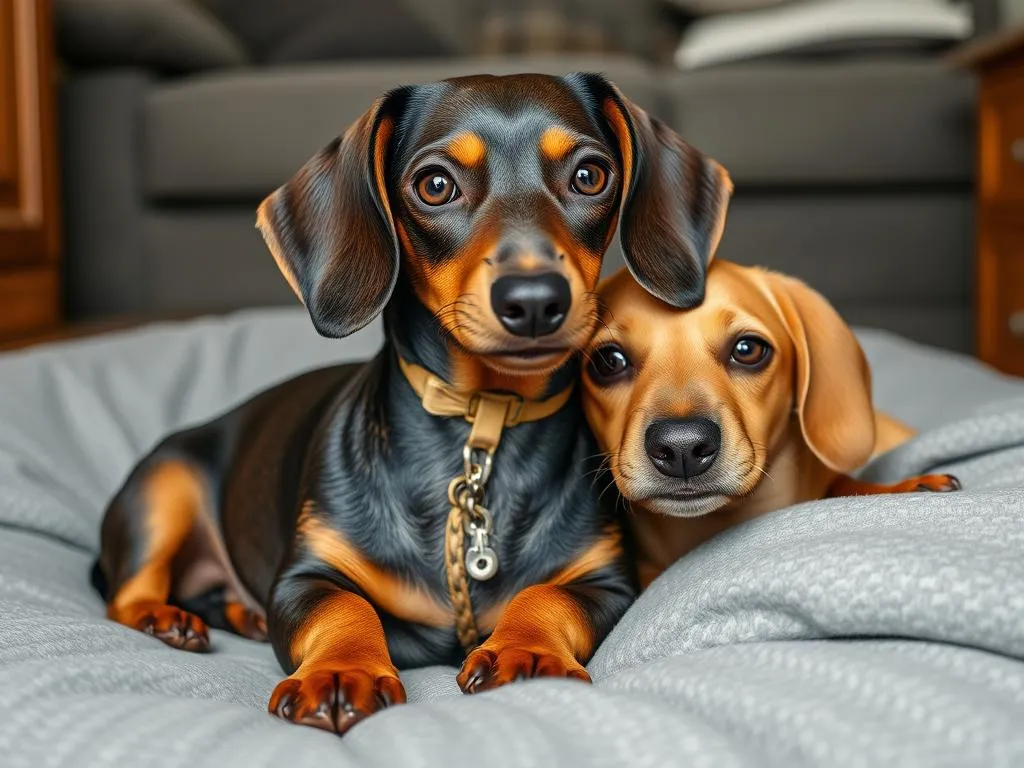
Introduction
The Dachshund, affectionately known as the “wiener dog,” has a unique charm that has captivated dog lovers for generations. Originating from Germany, these small yet spirited dogs were initially bred to hunt badgers. Their name translates to “badger dog” in German, a nod to their burrowing capabilities. Dachshunds come in three coat types: smooth, long-haired, and wire-haired, each with distinct characteristics.
Despite their small stature, Dachshunds possess a bold personality and a strong sense of loyalty. They are often described as clever, curious, and sometimes stubborn, which can make training a delightful challenge. Their temperament can significantly influence how well they get along with other dogs in your home. Understanding dog compatibility is essential for ensuring a harmonious household, especially if you already have other furry friends.
This article will explore whether a Dachshund will be good with other dogs in my home, examining their temperament, factors affecting compatibility, preparation for a new dog, training tips, and real-life success stories.
Understanding Dachshund Temperament
General Traits
A typical Dachshund’s personality is lively and playful. They are known for their affectionate nature, often forming strong bonds with their owners. However, their boldness can sometimes lead to confrontational behavior toward other dogs, especially if they feel threatened or territorial.
The three coat types of Dachshunds contribute to subtle differences in temperament. Smooth Dachshunds tend to be more social and outgoing, while long-haired variants may exhibit a calmer demeanor. Wire-haired Dachshunds are often more independent and assertive, which can influence how they interact with other dogs.
Socialization Needs
Early socialization is crucial for Dachshunds to develop a well-rounded temperament. Introducing them to various environments, people, and other dogs can help reduce the likelihood of aggressive behavior or fearfulness.
Recommended socialization techniques include:
- Puppy classes: Enroll your Dachshund in a puppy training class to expose them to other dogs in a controlled environment.
- Playdates: Arrange playdates with other friendly dogs to help your Dachshund learn how to interact positively.
- Positive reinforcement: Reward your Dachshund with treats and praise when they display good behavior around other dogs.
Factors Influencing Compatibility
Size and Breed of Other Dogs
When considering whether a Dachshund will be good with other dogs in my home, size and breed are significant factors. Dachshunds are small dogs, and interactions with larger breeds can be risky if not managed properly. Larger dogs may inadvertently harm a Dachshund during play, so it’s crucial to supervise their interactions.
Certain breeds are more likely to get along well with Dachshunds, including:
- Smaller breeds: Dogs like Chihuahuas, Pugs, and Toy Poodles tend to have compatible energy levels and sizes.
- Gentle larger breeds: Calm breeds such as Golden Retrievers and Basset Hounds can be good companions if they are well-socialized and gentle.
Age and Energy Levels
Age differences can also play a role in compatibility. A young, energetic Dachshund may overwhelm an older, calmer dog, leading to stress or aggression. Conversely, an older Dachshund may not appreciate the boisterous play of a puppy.
Energy levels are equally important. A high-energy Dachshund will thrive with a similarly energetic dog, while a laid-back canine companion may be overwhelmed by their exuberance.
Individual Personalities
Every dog has its own unique personality, making it essential to assess each dog’s temperament before introducing them. Look for signs of aggression or fear, such as growling, baring teeth, or a tucked tail.
To ensure a positive relationship between a Dachshund and other dogs, consider the following:
- Temperament assessment: Spend time observing each dog’s behavior in various situations.
- Trial interactions: Arrange short, supervised meetings to gauge how well the dogs get along.
Preparing Your Home for a Dachshund
Creating a Safe Environment
Before bringing a Dachshund into your home, it’s essential to create a safe environment for all dogs. This involves dog-proofing your space by:
- Removing hazards: Ensure that small items, toxic plants, and food are out of reach to prevent accidental ingestion.
- Establishing safe zones: Create separate areas for each dog where they can retreat if feeling overwhelmed.
Introducing a New Dog
Introducing a Dachshund to other dogs should be done gradually to ensure a smooth transition. Here’s a step-by-step guide to help make introductions successful:
- Neutral territory: Start by introducing the dogs in a neutral space, like a park, to avoid territorial behavior.
- Leashed introductions: Keep both dogs on leashes to maintain control. Allow them to sniff each other while maintaining a safe distance.
- Positive reinforcement: Use treats and praise to reward calm behavior during the introduction.
- Short interactions: Begin with brief meetings, gradually increasing the duration as they become more comfortable with each other.
Training and Behavior Management
Basic Training Tips
Training is a vital aspect of ensuring a well-behaved Dachshund, especially when integrating them with other dogs. Essential commands such as “sit,” “stay,” and “leave it” can help manage their behavior in various situations.
Positive reinforcement is the most effective training method for Dachshunds. This approach involves rewarding your dog for desired behaviors, making them more likely to repeat those actions.
Addressing Behavioral Issues
Common issues may arise when integrating a Dachshund with other dogs, such as aggression, jealousy, or territoriality. Here are strategies to mitigate these challenges:
- Redirect negative behavior: If your Dachshund displays aggressive behavior, redirect their attention to a toy or command.
- Gradual desensitization: Expose your Dachshund to the other dog in short intervals, gradually increasing exposure as they become more comfortable.
- Consult a professional: If behavioral issues persist, consider seeking help from a professional dog trainer or behaviorist to address specific concerns.
Success Stories and Case Studies
Personal Experiences
Many Dachshund owners have successfully integrated their dogs into multi-dog households. One owner shared their experience of introducing a Dachshund to a retired Greyhound. Initially, the Dachshund was fearful, but with gradual introductions and positive reinforcement, they formed a close bond. The owner emphasized the importance of patience and supervision during the early stages of their relationship.
Another owner recounted how their Dachshund learned to play gently with a young Boxer. By providing structured playtime and training sessions focused on acceptable behavior, both dogs became great companions.
Expert Opinions
Veterinarians and professional dog trainers often recommend specific breeds that pair well with Dachshunds. Breeds like Cavalier King Charles Spaniels and Maltese are suggested due to their gentle nature and compatibility with Dachshunds’ playful demeanor.
Experts also emphasize the importance of ongoing training and socialization, suggesting that owners regularly engage their Dachshunds in doggy playgroups to reinforce social skills and good behavior.
Conclusion
In conclusion, whether a Dachshund will be good with other dogs in my home largely depends on various factors, including temperament, size, age, and individual personalities. Early socialization, proper introductions, and training are crucial elements in fostering positive relationships between dogs.
Dachshunds can thrive in multi-dog households, provided that their unique needs and characteristics are considered. With the right preparation and management, your Dachshund can enjoy the companionship of other dogs, leading to a joyful and harmonious home environment. As every situation is unique, it’s essential to assess your own circumstances and the personalities of all dogs involved before making decisions.








